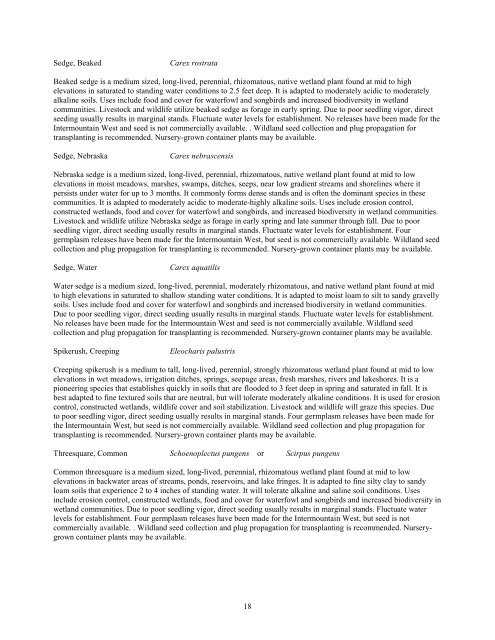Idaho Plant Materials Technical Note No. 24
Idaho Plant Materials Technical Note No. 24
Idaho Plant Materials Technical Note No. 24
Create successful ePaper yourself
Turn your PDF publications into a flip-book with our unique Google optimized e-Paper software.
Sedge, Beaked<br />
Carex rostrata<br />
Beaked sedge is a medium sized, long-lived, perennial, rhizomatous, native wetland plant found at mid to high<br />
elevations in saturated to standing water conditions to 2.5 feet deep. It is adapted to moderately acidic to moderately<br />
alkaline soils. Uses include food and cover for waterfowl and songbirds and increased biodiversity in wetland<br />
communities. Livestock and wildlife utilize beaked sedge as forage in early spring. Due to poor seedling vigor, direct<br />
seeding usually results in marginal stands. Fluctuate water levels for establishment. <strong>No</strong> releases have been made for the<br />
Intermountain West and seed is not commercially available. . Wildland seed collection and plug propagation for<br />
transplanting is recommended. Nursery-grown container plants may be available.<br />
Sedge, Nebraska<br />
Carex nebrascensis<br />
Nebraska sedge is a medium sized, long-lived, perennial, rhizomatous, native wetland plant found at mid to low<br />
elevations in moist meadows, marshes, swamps, ditches, seeps, near low gradient streams and shorelines where it<br />
persists under water for up to 3 months. It commonly forms dense stands and is often the dominant species in these<br />
communities. It is adapted to moderately acidic to moderate-highly alkaline soils. Uses include erosion control,<br />
constructed wetlands, food and cover for waterfowl and songbirds, and increased biodiversity in wetland communities.<br />
Livestock and wildlife utilize Nebraska sedge as forage in early spring and late summer through fall. Due to poor<br />
seedling vigor, direct seeding usually results in marginal stands. Fluctuate water levels for establishment. Four<br />
germplasm releases have been made for the Intermountain West, but seed is not commercially available. Wildland seed<br />
collection and plug propagation for transplanting is recommended. Nursery-grown container plants may be available.<br />
Sedge, Water<br />
Carex aquatilis<br />
Water sedge is a medium sized, long-lived, perennial, moderately rhizomatous, and native wetland plant found at mid<br />
to high elevations in saturated to shallow standing water conditions. It is adapted to moist loam to silt to sandy gravelly<br />
soils. Uses include food and cover for waterfowl and songbirds and increased biodiversity in wetland communities.<br />
Due to poor seedling vigor, direct seeding usually results in marginal stands. Fluctuate water levels for establishment.<br />
<strong>No</strong> releases have been made for the Intermountain West and seed is not commercially available. Wildland seed<br />
collection and plug propagation for transplanting is recommended. Nursery-grown container plants may be available.<br />
Spikerush, Creeping<br />
Eleocharis palustris<br />
Creeping spikerush is a medium to tall, long-lived, perennial, strongly rhizomatous wetland plant found at mid to low<br />
elevations in wet meadows, irrigation ditches, springs, seepage areas, fresh marshes, rivers and lakeshores. It is a<br />
pioneering species that establishes quickly in soils that are flooded to 3 feet deep in spring and saturated in fall. It is<br />
best adapted to fine textured soils that are neutral, but will tolerate moderately alkaline conditions. It is used for erosion<br />
control, constructed wetlands, wildlife cover and soil stabilization. Livestock and wildlife will graze this species. Due<br />
to poor seedling vigor, direct seeding usually results in marginal stands. Four germplasm releases have been made for<br />
the Intermountain West, but seed is not commercially available. Wildland seed collection and plug propagation for<br />
transplanting is recommended. Nursery-grown container plants may be available.<br />
Threesquare, Common Schoenoplectus pungens or Scirpus pungens<br />
Common threesquare is a medium sized, long-lived, perennial, rhizomatous wetland plant found at mid to low<br />
elevations in backwater areas of streams, ponds, reservoirs, and lake fringes. It is adapted to fine silty clay to sandy<br />
loam soils that experience 2 to 4 inches of standing water. It will tolerate alkaline and saline soil conditions. Uses<br />
include erosion control, constructed wetlands, food and cover for waterfowl and songbirds and increased biodiversity in<br />
wetland communities. Due to poor seedling vigor, direct seeding usually results in marginal stands. Fluctuate water<br />
levels for establishment. Four germplasm releases have been made for the Intermountain West, but seed is not<br />
commercially available. . Wildland seed collection and plug propagation for transplanting is recommended. Nurserygrown<br />
container plants may be available.<br />
18
















